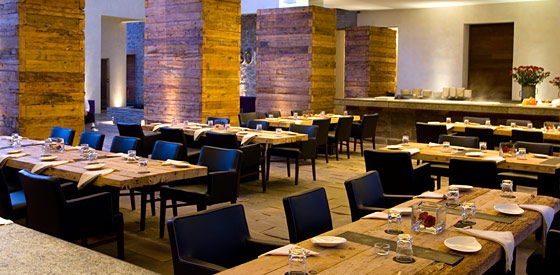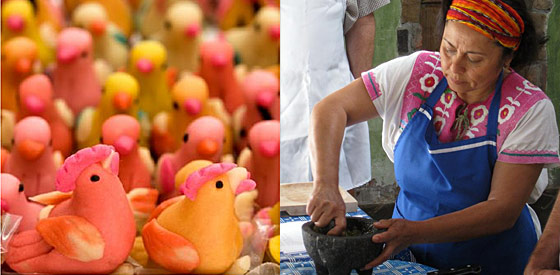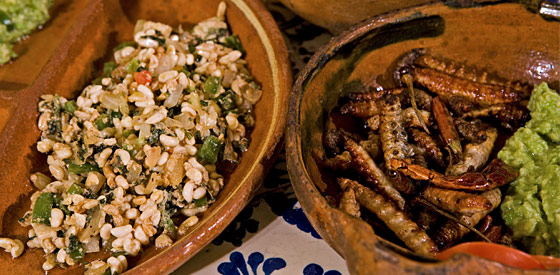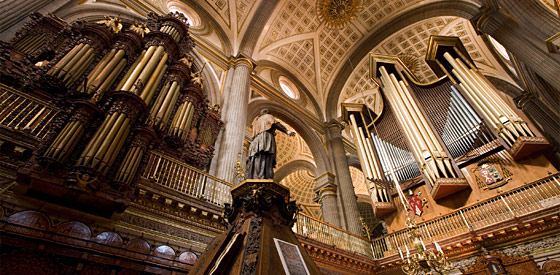1. Where to Stay

Rub shoulders with Mexico’s elite at La Purificadora (from $140), a fashionable property run by the company behind Mexico City’s buzzy hotel Condesa df. Built from the ruins of a water-purification plant, the building pairs factory aesthetics (reclaimed wood, loft-style ceilings) with modern luxuries like a rooftop pool.
Expand your art knowledge at El Sueño Hotel & Spa (from $133, breakfast included), where each of the thirteen high-ceilinged rooms is named for a female Mexican artist and decorated to evoke her spirit. The hot tub on top of this former eighteenth-century mansion offers a retreat from the frenetic streets of the centro historico.
Stay close to the massive central plaza at Hotel Provincia Express (from $33, breakfast included), a no-frills inn that’s outfitted with large quantities of Puebla’s brightly colored, intricately patterned talavera tile. The rooms are modest in size but immaculately maintained.
2. Where to Eat

Try international twists on traditional ingredients at the Restaurant at La Purificadora, a loftlike eatery with unfinished walls and long wood-plank tables designed for communal eating. Enrique Olvera, the CIA-trained chef-owner of Mexico City’s celebrated Pujol, designed a menu whose standout dishes include duck-confit-and-caramelized-onion chalupas ($7.90), tequila demi-glace-topped Angus skirt steak ($15.40), and jumbo shrimp with chipotle hollandaise sauce ($24.50).
Dine in the outdoor courtyard of the Nuevo Museo Universitario Interactivo at La Casa de los Muñecos, whose sprawling menu offers eclectic plates with uniquely Mexican touches, like crepes filled with huitlacoche and bathed in salsa poblano ($8) and grilled chicken lasagna with mole ($8). For a taste of classic Poblano fare, try the pipián verde (chicken in roast-pumpkin-seed sauce, $11.60).
Taste five kinds of house-made moles served over pork, chicken, or duck ($10.50) at El Mural de los Poblanos, where classic fare meets creative flourishes. Here, the chile relleno ($7.85) is a dried ancho chile filled with smoky goat cheese. Peruse the impressive list of 25 tequilas, and be sure to try the refreshing cucumber martini ($5.80)
3. What to Do

Tackle the building blocks of contemporary Poblano cooking at the Mexican Home Cooking School, where classes ($100 per person, including lunch, dinner, and drinks) cover everything from beef in mole verde to squash blossom soup, with plenty of customized instruction. Run by local Estela Silva and her Californian husband, the classes are held at the couple’s hacienda in Tlaxcala, 45 minutes from Puebla by taxi ($20 one-way, arranged through the school), and capped at six people per session. Book in advance.
Find culinary inspiration at the Venustiano Carranza Market (4 Poniente between 11 and 13 Norte), which offers piles of fresh herbs, dried spices, produce, and meats, hauled fresh from the surrounding countryside each morning. For the newest addition to Puebla’s food scene, head across the street to the 73,000-square-foot Mercado de Sabores Poblanos. This $4.1 million market-cum-food court serves local specialties like cemitas, pipián verde, and tacos árabes from 130-odd vendors in crisp, modern stalls. Don’t miss the dulces tipicas (about $1)—traditional Poblano sweets like camotes (candied sweet potato sticks) and jamoncillos (bars of pumpkin seed paste)—in the city’s dulceria district, located on the two blocks of Avenida 6 Oriente east of Avenida 5 de Mayo.
Explore the local watering holes by starting at Pulmex (Calle 4 Sur, between Calle 5 and 7 Oriente; no phone), a modest storefront where you can slurp pulque (85 cents for a cup, $2.50 for a liter), the lightly fermented pre-Columbian brew made from the sap of the maguey plant. Get a taste of Mexico’s burgeoning microbrewery movement at Barra Beer (5 Poniente 705; 222-298-0554), featuring hard-to-find domestic craft cervezas, like Primus and Cucapá ($3.25 to $4.60). For something a bit more potent, try a small sampling of mescals ($2.50) at A Go Go (3 Oriente 603; no phone), a trendy bar catering to the art-school set.
4. Insider’s Tip

Puebla is a great spot for adventurous eaters, but the city’s seasonal specialties are often not on the menu. To expand your culinary horizons, head to La Casa de los Muñecos and ask what’s in season (“platillos de temporada”). Depending on the time of year, you’ll find exotic regional ingredients like escamoles (ant larvae, available March through June), gusanos de maguey (worms that are typically served in a sauce of chile and pulque, April through May), huitlacoche (corn fungus, June through October), and chapulines (grasshoppers, October through November). Check the markets for street-food staples like crunchy fried chapulines with chile, served in paper cups.
5. Oddball Day

Have a small breakfast at your hotel before heading out for a day of architecture gazing and museum hopping. Start at the city’s Municipal Tourist Office on the east side of the central square, where you can get oriented by picking up a free map and checking out the bronze bas-relief of Puebla’s downtown area. Then, duck into the nearly 500-year-old Puebla Cathedral, which is depicted on Mexico’s 500-peso note, for a glimpse of its ornate chapels and frescoes. Two blocks away, visit Museo Amparo ($2.90), housed in two linked sixteenth- and seventeenth-century colonial buildings, where eight rooms are loaded with precolonial artifacts, like Mesoamerican ceramics and carved stone. Stop into vegetarian restaurant La Zanahoria (Av 5 Ote 206; 222- 232-4813) for a twist on the classic Mexican three-course prix fixe lunch ($4.60), which here might include salad, soup, mushroom-stuffed cactus paddles, and fresh fruit juice (the menu changes daily).Take time to visit the Nuevo Museo Universitario Interactivo and the City’s Casa de la Cultura, which also houses one of the oldest libraries in the country. Afterward, browse the souvenir stalls at the Parian Crafts Market, where many of the knickknacks and textiles are mediocre but are nonetheless worth perusing for decent budget-grade talavera pottery. For dinner, head to El Patio de Las Ranas (Av 2 Pte 205; 222-232-1946) for tacos árabes, one of Puebla’s great “fusion” dishes: marinated, spit-grilled pork al pastor, wrapped in fresh-baked Middle Eastern flatbread ($1 per taco). Have an after-dinner cocktail at the rooftop bar of the new boutique hotel, Puebla de Antaño. You’ll find 27 different martinis here, but you’re better off with a classic margarita ($8).
6. Links
Written by a former Wired editor living in Puebla, All About Puebla dubs itself “a gringa’s guide to the culinary capital and Colonial heart of Mexico.” It is, by leaps and bounds, the best English-language resource on the city.
Mex Connect is a good place to read up on Puebla’s culinary history (do a search) or seek travel advice on the site’s expat-heavy forum.
The bare-bones Visit Mexico tourism site has brochures, maps, and limited—and sometimes outdated—information on museums, architecture, and local highlights.
Puebla’s Spanish-language city government website is worth a visit, if only for its collection of virtual postcards.